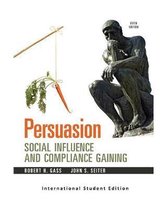Persuasion – Social Influence and Compliance Gaining (2016)
Gass & Seiter
Summary by Marloes Evertzen
October 2017
, Chapter 1 - Why Study Persuasion?
Persuasion is pervasive, we are surrounded by influence attempts, both explicit and implicit, no matter
where we are. Also, it is difficult to say with any certainty what is and is not “persuasion”. Where do
you draw the line between persuasion and other forms of communication? The study of persuasion
has gotten some bad publicity over the years. People link it to manipulation or deceit.
Persuasion is our friend
Persuasion isn’t merely a tool used by con-artists. Most “professional” persuaders (writers, journalists,
celebrity endorsers, talk show hosts, etc.), are engaged in socially acceptable and respected careers.
Persuasion helps forge peace agreements between nations, it helps open closed societies. It’s funda-
mental in fundraisers and tells, for example, motorists to buckle up when driving. Very little of the
good that we see in the world could be accomplished without persuasion.
The pervasiveness of persuasion
A couple of ways to persuade include:
1. Word of mouth: Buzz marketing relies on friendships to spread the word. Therefore, it is es-
sential to be perceived as genuine. Word of mouth succeeds when it’s authentic, rather than
choreographed, and peer-driven, rather than corporate sponsored. It’s a cheap method of ad-
vertising and it is especially effective with younger people.
2. Social media: these new media are important mediums for influence. Social media is so im-
portant that companies now specialize in sentiment tracking, a process of monitoring and
measuring social media to gauge the public’s mood in real time. Software can track how a
person, brand, or issue is trending based not only on the number of tweets generated, but also
on how favourable, neutral, or negative those tweets are.
3. Tipping points: once a message gains a certain amount of momentum (through WOW, social
media, etc.), it reaches a tipping point and becomes “contagious”. To reach tipping point, a
few things need to happen:
a. Über influencers: The right kind of people must be involved. Three types of people are
essential in the process:
i. Mavens: possess specialized expertise, they are in the know. They are the
early adopters.
ii. Connectors: they have a large social network and get told what the “next big
thing is”.
iii. Salespeople: receive the message from a connector and talk it up within their
own circle of friends.
b. Orchestrating the next big thing: there are some conditions for an idea to go viral:
. Context: the idea must come along at the right time and place.
i. Stickiness: the idea should be inherently attractive.
ii. Scalability: it must be easy to ramp up production of the idea, product, or mes-
sage to meet demand.
iii. Effortless transfer: a viral campaign must leverage free media. The more time,
effort, or money it takes, the less possible it will go viral.
c. Infectious or inexplicable?: many messages go viral, but few are planned, deliberate
efforts to persuade. Orchestrating a viral campaign can be difficult.
4. Gamification: Farmville as a Cash Cow: gamification applies videogame methods to other con-
texts to increase consumer engagement. People like to play games. Games can also be used
as a form of influence.
2
, 5. Persuasion in the sciences: scientists are persuaders. Scientists often must convince others
that their research possesses scientific merit and social value. They also must argue for the
superiority of their own paradigms over those of their rivals.
6. Persuasion in the arts: not all art is created “for art’s sake”. Art serves more than an aesthetic
or decorative function. Artists have strong opinions and they lend expression to their opinions
in and through their work. Movies such as Schindler’s List demonstrate how powerful a camera
is to increase awareness or change attitudes.
7. Other contexts for persuasion: bumper stickers, intercessory prayer (offered for the benefit of
another person) on recovery from illness, support groups. compliance gaining techniques used
in dramatic plays.
8. Weird persuasion: for example, a town in Texas agreed to rename their town as part of an
endorsement deal with Dish Network, in return, the company promised all 125 residents free
satellite TV service for 10 years. This was all for free publicity.
9. Persuasion in interpersonal settings: interpersonal influence is often more effective because it
is more genuine and seems less conspicuous. One vital aspect of human symbolicity involves
the tendency to persuade others. We are symbol users, and one of the principal functions of
symbol usage is persuasion.
Four benefits of studying persuasion
• The instrumental function: learning about persuasion is to become a more effective persuader
yourself. Communication competence involves acting in ways that are perceived as effective
and appropriate. Competent communicators possess the skills needed to achieve their objec-
tives in fitting ways for the situation. A competent persuader needs to know how to analyse
an audience to adapt the message to the audience’s frame of reference. How can the message
be the most successful?
• The knowledge and awareness function: learning about persuasion will enhance your
knowledge and awareness of a variety of persuasive processes. Knowledge is power. An addi-
tional benefit includes overcoming habitual persuasion, people get comfortable with tactics
and use them repeatedly, it becomes “mindless”.
• The defensive function: by studying how and why influence attempts succeed or fail, you can
become a more discerning consumer of persuasive messages. If you know how it works, you
are less likely to be taken in by it.
• The debunking function: the study of human influence can aid in dispelling various “common
sense” assumptions and “homespun” notions about persuasion. A lot of people tend to cling
to old beliefs, which might not even work well. By learning about persuasion, the researcher
can learn to ferret the true from the false, the fact from the fiction.
Two criticisms of persuasion
• Does learning about persuasion foster manipulation?: the authors view the means of persua-
sion not so much as moral or immoral, but as amoral, or ethically neutral. Persuasion is a tool
that can be put to good or bad use. The persuaders motives determine whether a given influ-
ence is good or bad.
• Are persuasion findings too inconsistent or confusing?: the authors believe that persuasion
warrants study precisely because it is so elusive. Also, persuasion research has revealed many
significant, relevant generalizations.
Ethical concerns about the use of persuasion
The authors position is that learning how to become a more effective persuader, you should strive to
be an ethical persuader as well. More about this in the last chapter.
3
, Chapter 2 - What Constitutes Persuasion?
Different authors view persuasion in diverse ways. It also goes by a variety of other names, such as:
advising, brainwashing, coercion, compliance gaining, convincing, education, indoctrination, influence,
manipulation, and propaganda.
Pure versus borderline cases of persuasion
By pure persuasion, the authors mean clear-cut cases of
persuasion, on which most people would agree (presi-
dential debate, attorneys’ closing remarks). Such exam-
ples represent paradigm cases, because they are at the
core of what we think of when we envision persuasion
at work. Other instances lie closer to the boundary of
periphery of what we normally think of persuasion,
these are the borderline cases of persuasion. The prelim-
inary model of the scope of persuasion illustrates this
distinction in approaches. (Line should be fuzzy).
Limiting criteria for defining persuasion
1. Intentionality: is persuasion necessarily conscious or purposeful? Certainly, pure persuasion
would seem to be intentional. The authors believe that borderline persuasion can take place
without conscious awareness on the part of the persuader. For example, parents pass a lot of
their own beliefs onto their children, which is known as social modelling. In the socialization
process, children are socialized into their respective gender roles, cultural customs, etc. Inten-
tionality is difficult to label, because people do not always know what specific outcome they
are seeking. Another problem involves situations in which there are unintended receivers, a
third party could overhear a conversation and place a wager on the horse. Another limitation
lies in the difficulty of ascertaining another’s intent. There could be a difference between the
stated and actual intent. Resolving the issue of intent is particularly difficult in interpersonal
contexts, in which both parties may be engaged simultaneously in attempts at influence.
2. Effects: has persuasion taken place if no one is persuaded? The authors believe that it was still
persuasion if it was ineffective. Persuasion is best understood as an activity in which people
engage. Also, there is not just one receiver and transmitter. Both parties are simultaneously
altering their conversation as they go. It is often difficult to measure persuasive effects.
3. Free will and conscious awareness: the authors believe persuasion can and does occur without
the conscious awareness of receivers. For example, people reading resumes on heavier clip-
boards judged the applicants as better, than those who had lighter clipboards. Many influence
attempts succeed precisely because they operate at a low level of awareness. Most influence
attempts we encounter in daily life include both persuasive and coercive elements. It all de-
pends on how coercive or persuasive a situation is to work.
4. Symbolic action: this includes language and other meaning-laden acts, such as civil disobedi-
ence and protest marches. This approach focusses on the means. or channel, of persuasion as
a limiting criterion. Authors who limit the scope of persuasion to symbolic interaction fear that
without such a limitation, all human behaviour could be constructed as persuasion. However,
the authors believe this leaves out too much. They believe that some of the most intriguing
aspects of persuasion can be found in nonverbal behaviour. Persuasion involves more than
language or symbol usage.
5. Interpersonal vs. intrapersonal: how many actors are required for persuasion to take place?
Some scholars say it takes two, the authors believe it can even take one, called self-persuasion.
This is when people decide and seek reasons to do it or not.
4





